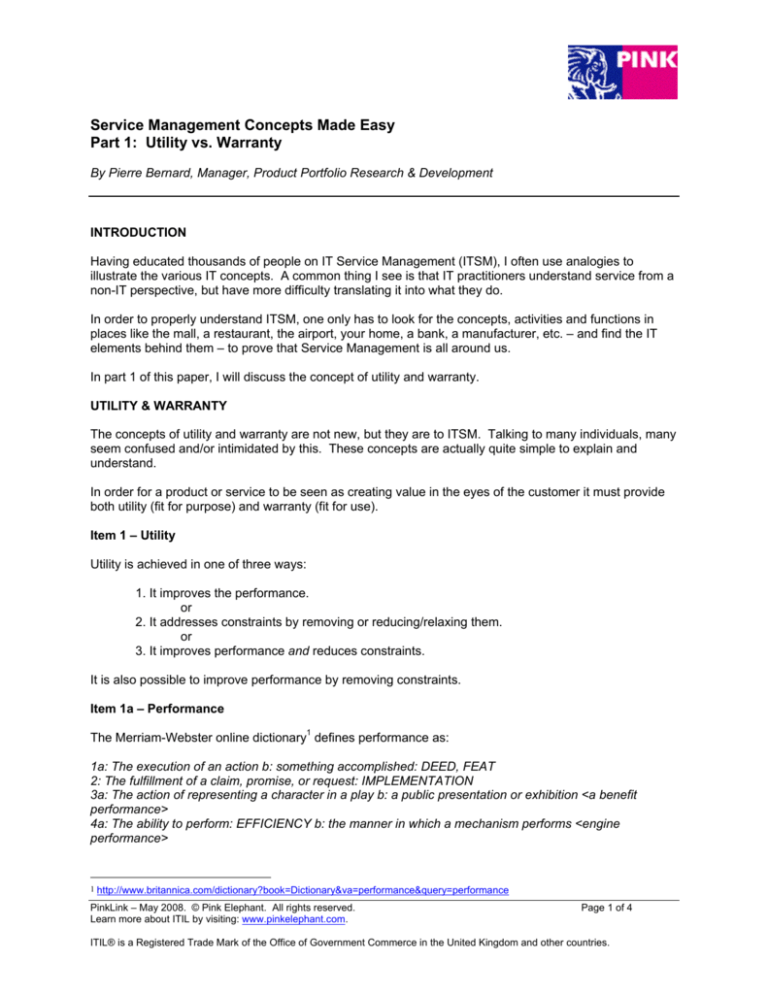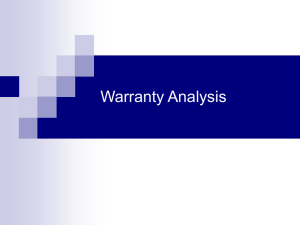
Service Management Concepts Made Easy
Part 1: Utility vs. Warranty
By Pierre Bernard, Manager, Product Portfolio Research & Development
INTRODUCTION
Having educated thousands of people on IT Service Management (ITSM), I often use analogies to
illustrate the various IT concepts. A common thing I see is that IT practitioners understand service from a
non-IT perspective, but have more difficulty translating it into what they do.
In order to properly understand ITSM, one only has to look for the concepts, activities and functions in
places like the mall, a restaurant, the airport, your home, a bank, a manufacturer, etc. – and find the IT
elements behind them – to prove that Service Management is all around us.
In part 1 of this paper, I will discuss the concept of utility and warranty.
UTILITY & WARRANTY
The concepts of utility and warranty are not new, but they are to ITSM. Talking to many individuals, many
seem confused and/or intimidated by this. These concepts are actually quite simple to explain and
understand.
In order for a product or service to be seen as creating value in the eyes of the customer it must provide
both utility (fit for purpose) and warranty (fit for use).
Item 1 – Utility
Utility is achieved in one of three ways:
1. It improves the performance.
or
2. It addresses constraints by removing or reducing/relaxing them.
or
3. It improves performance and reduces constraints.
It is also possible to improve performance by removing constraints.
Item 1a – Performance
The Merriam-Webster online dictionary1 defines performance as:
1a: The execution of an action b: something accomplished: DEED, FEAT
2: The fulfillment of a claim, promise, or request: IMPLEMENTATION
3a: The action of representing a character in a play b: a public presentation or exhibition <a benefit
performance>
4a: The ability to perform: EFFICIENCY b: the manner in which a mechanism performs <engine
performance>
1
http://www.britannica.com/dictionary?book=Dictionary&va=performance&query=performance
PinkLink – May 2008. © Pink Elephant. All rights reserved.
Learn more about ITIL by visiting: www.pinkelephant.com.
Page 1 of 4
ITIL® is a Registered Trade Mark of the Office of Government Commerce in the United Kingdom and other countries.
Performance is quite simply the ability to do more in less time and/or requiring less efforts and/or
consuming fewer resources as compared to a previously established baseline.
The world of sports is full of stories of athletes who have performed better than others (especially during
championships) or better then they did in previous years. Their performance exceeded those of others or
their previous personal best.
But improving performance is not always possible, or the desired outcome. At some point in time the
costs and efforts required to improve performance far outweigh the (potential) benefits. For example, it is
far easier for me (middle-age man, out of shape, slightly overweight) to reduce the times it takes to run
100 meters (109.3 yards) from say 20 seconds to 13 seconds than for a world class sprinter to go from
10.0 seconds to 9.95 seconds. In my case, since I don’t want to become a world class sprinter, the cost
for me to try to achieve that level would far outweigh the benefits for me.
Item 1b – Constraints
Now we turn our attention to removing or relaxing constraints. A constraint is a restriction, an inability to
execute a specific task or activity. Earlier in my career I was managing a team of trainers and was a
trainer myself. I needed to be more accessible to my team, so I had to look at acquiring a new mobile
phone that would give me access to my email and the internet. By doing this, I removed a significant
constraint. I had no need to address the performance aspect of utility because utility was addressed in a
satisfactory manner.
Item 2 – Warranty
Looking only at utility is not enough. We have to consider the warranty aspect as well. The warranty is
not the card found in the box of the small kitchen appliance we just bought and that tells us that the
product should be free of defects for a finite period from the time of purchase.
In Service Management, warranty is provided if and only if four distinct conditions are all met:
1.
2.
3.
4.
Is the service available enough?
Is there enough capacity?
Is it secure enough?
Is it continual enough?
Unlike utility, warranty requires that all of the four conditions mentioned above are met. If even just one is
missing, then the warranty aspect is not met and the value creation is not realized.
Item 2a – Availability
Keeping with our mobile phone example, we can say that many phones give us the ability to still be able
to use our phones when we travel across many regions. This was not always the case. In the early days
of mobile technology the coverage was usually limited to major urban centers. Nowadays the coverage is
lot more extensive and thus more “available” to us.
Item 2b – Capacity
A customer may perceive a service to be unavailable if there is insufficient capacity. A great example of
this relates to traffic gridlock in the downtown core of most major urban centers. The roads are available
because they exist but the capacity to handle today’s volumes of traffic is insufficient. It is next to
impossible to expand the roads in a downtown area. Therefore, city and traffic planners as well as
organizations must come up with innovative solutions.
PinkLink – May 2008. © Pink Elephant. All rights reserved.
Learn more about ITIL by visiting: www.pinkelephant.com.
Page 2 of 4
ITIL® is a Registered Trade Mark of the Office of Government Commerce in the United Kingdom and other countries.
Item 2c – Security
Security is a major concern in today’s technologically-enabled world. We have to balance our need and
desire for security against not only the monetary costs but its (potential) counter-effect on utility. There
are of course many security measures that can be used based on the importance attached to the
information/product/service. Such security measures include prevention, reduction, detection, repression,
and correction. However, being too secure could impact performance and impose new constraints.
Things can be so secure that the service becomes unavailable to the users. It is a difficult balancing act,
but it needs to be addressed.
Item 2d – Continuity
Finally, we come to the continuity of the service. Are there measures in place (from ‘do nothing’ to
‘immediate recovery’)? The spare tire/wheel in your car allows you to continue your journey should you
experience a flat tire. However there are crisis situations where “do nothing” is the correct thing to so. A
great example is the huge power outage that affected many eastern seaboard states in the USA as well
as many provinces in Canada, especially Ontario, in the summer of 2003.
At the time I was delivering a workshop in downtown Toronto, so I experienced this first hand. A couple
of interesting things happened. Backup and redundant systems became active; services remained
available to various business customers in the unaffected regions (i.e.: The rest of the world). Things
worked as designed; however, in some organizations, the decision was made not to invoke any of the
continuity plans. Why? The answer is simple: the business units and their customers had no power
themselves. People were more interested in finding ways to go home and keep in touch with family and
loved ones.
This brings me to the complaints many had that the phone systems failed as well. The fact is that the
phone systems worked as designed. People received a busy signal. The issue was related to the
capacity of the phone systems. They simply did not have the capacity to handle all those millions of calls
made during that short period of time. All we had to do was to be patient and we would eventually
connect with our family and loved ones.
Is warranty independent of utility? Of course not! One influences, and is influenced by, the other. The
value creation will only be realized if the utility and warranty aspects are both met.
It is important to add another level of complexity in the mix. Customers are people, not robots. People
have preferences and filters called perception. These preferences and perceptions are based on prior
experiences with the service or based on other people’s experiences (word-of-mouth). In turn, the
perception and preferences are affected by the attributes of the service. For example, people who often
travel have a much different perception about it than those people who rarely travel. Flying in
executive/business class on some airlines today is much different (attributes) than flying with a carrier that
only offer one seating class. I will choose the appropriate service based on my perceptions of the two
classes, my preferences (may vary if it is a long- vs. short- haul flight) and the attributes of the service
(cost being only one of them).
The above means that you must set expectations and for this you often need to communicate face-toface.
Summary Of Utility & Warranty
To summarize, we need to build our services that enable the business (and in many cases now our
business customers) to perform better and/or with features that remove or reduce constraints (real or
perceived) affecting the people using our services. When looking at the warranty aspect we need to
design our services to be available when our customers need it. We have to build in sufficient capacity to
PinkLink – May 2008. © Pink Elephant. All rights reserved.
Learn more about ITIL by visiting: www.pinkelephant.com.
Page 3 of 4
ITIL® is a Registered Trade Mark of the Office of Government Commerce in the United Kingdom and other countries.
enable utility and availability. The whole thing has to meet the security requirements from our customers
as well as those dictated by legislation, but not to the detriment of utility or the other three warranty
components.
Finally, the service must be provided in a continuous fashion usually (close) to the same levels as in
normal operations, but often with reduced attributes such as performance or capacity. This is usually
negotiated with the business and communicated to the end-user community to manage expectations.
PinkLink – May 2008. © Pink Elephant. All rights reserved.
Learn more about ITIL by visiting: www.pinkelephant.com.
Page 4 of 4
ITIL® is a Registered Trade Mark of the Office of Government Commerce in the United Kingdom and other countries.







